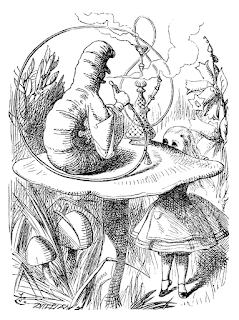The Philosophy of Alice in Wonderland
The famous children's novel "Alice in Wonderland" is not your average children's book. This imaginative story was written by author, logician, mathematician, and photographer Lewis Carrol in 1865. "Alice" isn't your typical fairy tale love story with a happily ever after type ending. Instead, this book is about the colorful adventures of a brave little girl who has "fallen down the rabbit hole" and must use her wits to help her get back out. Alice in Wonderland covers many philosophical topics such as psychedelics, reality versus dreaming, the logical and illogical, the impossible, and proper gender roles.
Drugs and Reality
Alice brings into play the questioning of reality. The certain amount of
skepticism that what we perceive as reality or normal
experience isn’t. Plato
and Chou also ask this question of dreaming vs reality. How do we know if we
are dreaming ourselves at this moment because we aren’t aware of one state or
the other? Alice experiences almost the same dialogue Plato created, with the
cat telling her she is mad, but unlike us she doesn’t know she’s dreaming and
denies that she is mad because she’s unaware of the state she is in. Some
philosophers believe that drugs can actually enhance and bring us to see the
true world around us. With us only hearing and seeing a limited amount of
spectrum in the world around us, drugs allow us to see the world as it truly is
through mystical experiences.
(Whitney Ingle)
Six Impossible Things Before Breakfast
(Elsbeth Embretson)
Gender Roles
The female leads in most fairy tales follow similar gender stereotyped patterns. These characters are usually a damsel in distress waiting for a man to
save her. The dainty damsel is usually a victim of some kind of cruel life circumstance that she is powerless to and unable to change on her own. The heroine Alice is a completely different
kind of female character. Alice stands up for herself, takes charge, and doesn’t
need a man or even an adult to save her. The questions concerning gender roles in Carol's "Alice" are questions that have long been debated by philosophers throughout the years. It is a common opinion especially among ancient philosophers, that women are the weaker of the sex and have a certain place in society as wives, mothers, and helpmates. Carol's heroine challenges these outdated feminine roles, and celebrates feminine strength, freedom, and capability.
(Morgan Massey)




No comments:
Post a Comment
Note: Only a member of this blog may post a comment.